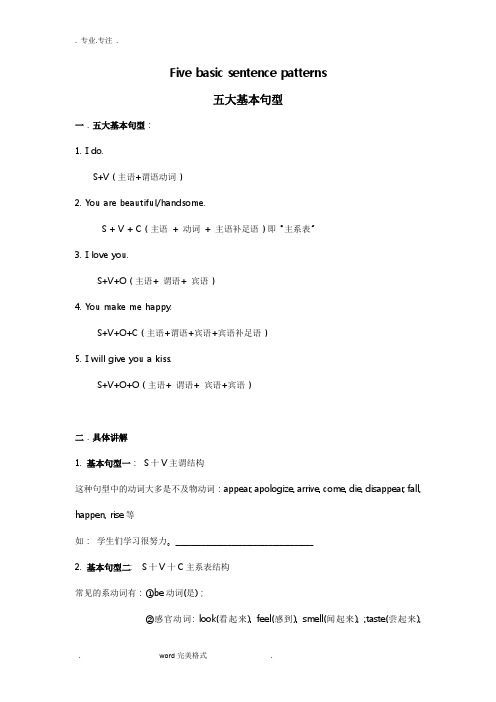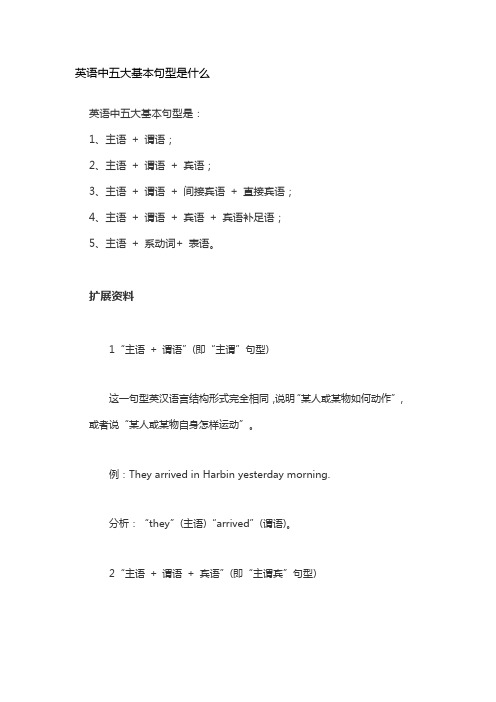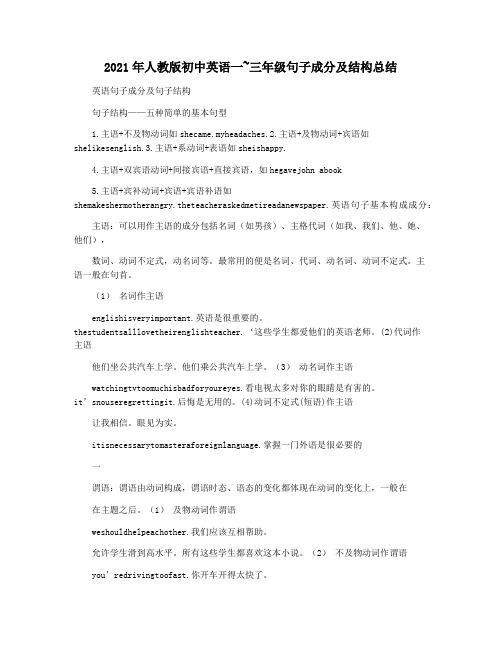1五种基本句型结构
高中英语课件 必修一 unit1五种基本句型

S
V
IO
DO
1. She passed him
2. She cooked her
3. He brought him
4. He bought youΒιβλιοθήκη 5. I showed her
6. I gave him
7. I told
him
8. He showed me
a new dress. a delicious meal. a dictionary. nothing. my pictures. a hand. how to run themachine. that the bus was late.
基本句型 五
S +V(及物动词) +O +OC (主+谓+宾+宾补)
此句型的句子的共同特点是:动词虽然
是及物动词,但是只跟一个宾语还不能表 达完整的意思,必须加上一个补充成分来 补足宾语,才能使意思完整。
S V(及物)O(宾语) C(宾补)
1. We keep
2. They painted
3. They call
1. S + V (主语+谓语) 2. S +V + O (主语+谓语 +宾语) 3. S+ Link V+P (主语+系动词 +表语) 4. S + V + IO+DO
(主语+谓语+间接宾语+直接宾语) 5. S +V +O +OC
(主语+谓语 +宾语+宾语补足语)
基本句型 一
S +V(不及物动词) (主+谓)
句子结构(1)五个基本句子结构

句子结构(1)五个基本句子结构句子结构(含be动词的简单句子)1. 第一句型的肯定句:(1) I am a boy. We are boys.(2) I am beautiful. We are beautiful.(3) I am a beautiful boy. We are beautiful boys.(4) She is a girl. They are girls.(5) He is a student. They are students.(6) It is a panda. They are pandas.(7) This is a book. These are books.(8) That is a pen. Those are pens.2. 第一句型的否定句(1) I am a boy. I am not a boy.(2) We are boys. We are not boys.(3) I am beautiful. I am not beautiful.(4) I am a beautiful boy. I am not a beautiful boy.(5) She is a girl.She is not a girl.(6) They are students. They are not students.(7) This is a book. This is not a book.(8) Those are pens. Those are not pens.第一句型的否定句: 直接在be 动词后加not英语所有否定句的构成: 3. 第一句型的一般疑问句(1) I am a boy. Are you a boy?(2) We are boys. Are you boys?(3) I am beautiful. Are you beautiful?(4) I am a beautiful boy. Are you a beautiful boy?(5) She is a girl. Is she a girl?(6) They are students. Are they students?(7) This is a book. Is this a book?(8) Those are pens. Are those pens?[1]第一句型的一般疑问句为: 直接将be (am ,is ,are)动词提至句首。
英语高一必修一语法

英语高一必修一语法英语高一必修一的语法部分主要涵盖了基本句型、时态、动词的用法等内容。
本文将详细介绍其中的几个重要的语法知识点。
一、基本句型英语中的基本句型有五种,分别是陈述句、疑问句、祈使句、感叹句和条件句。
1. 陈述句:陈述句是表达事实或陈述观点的句子。
它的基本结构是主语+谓语+宾语,谓语可以是及物动词或不及物动词。
例如:- I like apples.- They are playing basketball.2. 疑问句:疑问句是用来提问的句子。
它的基本结构是助动词/系动词+主语+谓语+其他成分?例如:- Do you like apples?- Are they playing basketball?3. 祈使句:祈使句是用来表达请求、命令、建议等意思的句子。
它的基本结构是谓语+其他成分。
例如:- Close the door, please.- Don't play with fire.4. 感叹句:感叹句是表达强烈感情或赞叹的句子。
它的基本结构是How/What+形容词/副词+主语+谓语。
例如:- How beautiful the flowers are!- What a lovely day it is!5. 条件句:条件句是表示条件的句子。
它的基本结构是if/whether+句子。
例如:- If it rains tomorrow, we will stay at home.- Whether she comes or not, I will go to the party.二、时态在英语中,时态用于表示动作发生的时间。
高一必修一中涵盖了一般现在时、一般过去时、一般将来时等几个基本时态。
1. 一般现在时:一般现在时用于表示经常性的动作、习惯、真理、科学事实等。
它的基本结构是主语+谓语。
例如:- She goes to school every day.- Water boils at 100 degrees Celsius.2. 一般过去时:一般过去时用于表示过去发生的动作或状态。
高中英语五种基本句型

高中英语五种基本句型
高中英语学习中,五种基本句型是学习英语语法的重点
内容之一。
五种基本句型分别是简单句、并列句、复合句、介词短语和动名词短语。
下面将分别进行介绍。
一、简单句
简单句是英语语言学中最简单的句型,由主语和谓语构成。
例如:I am a student.我是一名学生。
二、并列句
并列句由两个或多个简单句通过并列连词连接成一个句子,构成并列关系。
例如:I like to play basketball, and my brother likes to play soccer.我喜欢打篮球,我的兄弟喜
欢踢足球。
三、复合句
复合句至少由一个主句和一个从句构成。
主句和从句之间通过连接词连接,构成了从属关系。
例如:After I finish my homework, I will go to bed.我做完作业后就去睡觉。
四、介词短语
介词短语由介词和宾语组成,可以用来修饰名词、代词或动词。
例如:The book on the table is mine.桌子上的书是我的。
五、动名词短语
动名词短语以动词-ing形式作为主语、宾语或表语。
例如:Playing basketball is my favorite activity.打篮球是我
最喜欢的活动。
以上就是英语语法中的五种基本句型,了解并正确运用这五种句型对于学习英语语法非常重要。
英语五大基本句型

Five basic sentence patterns五大基本句型一.五大基本句型:1. I do.S+V(主语+谓语动词)2. You are beautiful/handsome.S + V + C(主语+ 动词+ 主语补足语)即“主系表”3. I love you.S+V+O(主语+ 谓语+ 宾语)4. You make me happy.S+V+O+C(主语+谓语+宾语+宾语补足语)5. I will give you a kiss.S+V+O+O(主语+ 谓语+ 宾语+宾语)二.具体讲解1. 基本句型一:S十V主谓结构这种句型中的动词大多是不及物动词:appear, apologize, arrive, come, die, disappear, fall, happen, rise等如:学生们学习很努力。
_____________________________________2. 基本句型二: S十V十C主系表结构常见的系动词有:①be动词(是);②感官动词: look(看起来), feel(感到), smell(闻起来), ;taste(尝起来),sound(听起来);③表示状态的: seem(似乎), appear(似乎,好像), keep(保持), remain(仍是), stay(继续处于...状态)等等。
④表示转变或结果的: get(变得), become(成为), turn(变得),go(变成),grow(渐渐变得), fall(变得), prove(证明)1)我们在任何时候都应该保持安静。
We should __________ __________ any time.2)这种食物尝起来很糟糕。
_________________________________________________.3) 春天到了,天气变得越来越暖和。
Spring comes. It is ______________________________.4) 不要吃那种食物,它已经变质了。
句子的结构

句子的结构简单的五种基本句型:1.主语+不及物动词(主谓结构)I live (in a beautiful house).注意:主动形式表示被动含义型。
此类动词常见的有:read,sell, wash, write,clean等。
如:The film tickets sold well。
戏票很畅销.This kind of cloth washes well.这种布料很容易洗。
2.主语+系动词+表语(主系表结构)本结构是由"主语+系动词+表语”组成,主要用以说明主语的特征、类属、状态、身份等。
此句型中常见的系动词:be,become,come,get, smell,taste,feel, sound,remain, stay, appear, go, turn,fall, keep等.(1)主语+系动词+形容词(作表语)如:That argument sounds reasonable. 那个论据听起来有道理(2)主语+系动词+名词(作表语)如:Later he became a scientist.他后来成为一个科学家。
(3)主语+系动词+副词、介词短语或反身代词(作表语)如:He is near. 他在附近。
This is of importance. 这很重要.You're not looking yourself today。
今天你看上去气色不太好。
3。
主语+及物动词+宾语(主谓宾结构)此结构是由"主语+谓语+宾语"构成。
其中的谓语动词须是及物动词(短语),宾语须是名词或相当于名词的成分.主语+及物动词+名词或代词(作宾语)如:Will you spend your holidays abroad this year?你今年去国外度假吗?主语+及物动词+动名词(作宾语)。
如:I suggested taking a walk.我建议去散步。
主语+及物动词+不定式(作宾语)。
【精品】初中英语语法专题讲解1--简单句的5种基本句型

初中英语语法专题讲解 1——简单句的五种基本句型英语中千变万化的句子归根结底都是由以下五种基本句型组合、扩展、变化而来的:1)主+ 动(SV)例如:I work.我工作。
2)主+ 动+ 表(SVP)例如:John is busy.约翰忙。
3)主+ 动+ 宾(SVO)例如:She studies English.她学英语。
4)主+ 动+ 宾+ 补(SVOC)例如:Time would prove me right. 时间会证明我是对的。
5)主+ 动+ 间宾+ 直宾(SVOiOd)例如:My mother made me a new dress.我母亲给我做了一件新衣裳。
英语中的各种句子分为简单句和复合句,其中简单句中包含有五种基本句型。
1.S+Vi(Subject主语+Intransitive Verb不及物动词)例:The sun rises in the east.太阳从东方升起。
She is walking along the lake.她正沿着湖边走。
2.S+Vt+O(Subject主语+Transitive Verb及物动词+Object 宾语)例:He found a bird in the tree.他发现树上有一只鸟。
I like this book very much.我非常喜欢这本书。
3.S+link.V+P(Subject主语+link.verb系动词+Predicative 表语)1)句型中系动词的位置可以用be动词来代替。
2)句型中系动词可分为:表状态的系动词:be,keep,lie,look,remain,seem,smell,sound,sit,stand,stay,taste等。
表变化或结果的系动词:become,come,get,grow,go,fall,prove,turn等。
例:Time is up.时间到了。
That man seems kind.那人看起来很善良。
英语一轮复习--五种基本句型

4.He│admits│that he was mistaken. (从句)
5. I │ want │ to help you in fact. (不定式)
6. Tom │ doesn’t know │ what to do
(疑问词+不定式)
练习
1过去二十年我们取得了很大的进步。
We’ve made great progress in the past twenty years.
1. The red sun rises in the east. 2. Weak buildings will fall down in an earthquake, but strong ones may stay up. 主语可有修饰语-定语; 谓语可有修饰语-状语。
基本句型 一:S +V(主+谓)
to
take, give, bring, lend, offer, pass, hand, sell, send, show, write, pay
do, buy, choose, get, leave, paint, play(演奏), save, sing,
for
常跟双宾语的动词
• give, offer, teach, tell, ask, bring, pass, lend, write, throw, send,cost make, buy, do, get, save, cook, sing, find等。
基本句型 四: S+V(及物)+o(多指人) +O(多指物)
1.She │ordered │herself │a new dress. 2. He │brought │you │a dictionary. 3. I │showed │him │my pictures.
五种句型八大时态七大语法

五种句型八大时态七大语法一、五种句型1、简单句:由一个主语和一个谓语组成,是最基本的句型,如:He goes to school.2、并列句:由两个或两个以上的并列句子组成,如:He goes to school and she goes to work.3、复合句:由一个主句和一个从句组成,如:He goes to school when he is free.4、倒装句:将句子中的谓语动词放在主语之前,如:Here comes the bus.5、感叹句:表示感情的句子,如:What a beautiful day!二、八大时态1、一般现在时:表示经常性或习惯性的动作,如:He goes to school every day.2、一般过去时:表示过去发生的动作,如:He went to school yesterday.3、一般将来时:表示将来发生的动作,如:He will go to school tomorrow.4、现在进行时:表示正在进行的动作,如:He is going to school now.5、现在完成时:表示过去发生的动作对现在造成的影响,如:He has gone to school.6、过去进行时:表示过去正在进行的动作,如:He was going to school.7、过去完成时:表示过去发生的动作对过去造成的影响,如:He had gone to school.8、将来完成时:表示将来发生的动作对将来造成的影响,如:He will have gone to school.三、七大语法1、名词:表示人、事物或抽象概念的词,如:school, teacher, happiness.2、代词:替代名词的词,如:he, she, it.3、形容词:修饰名词的词,如:beautiful, tall, happy.4、动词:表示动作或状态的词,如:go, be, have.5、副词:修饰动词、形容词或其他副词的词,如:quickly, very, almost.6、介词:表示词与词之间的关系的词,如:in, on, at.7、连词:连接句子成分的词,如:and, but, or.。
【3年高考2年模拟】2016届人教版新课标高三英语一轮复习课件 写作指导一 五种基本句型

答案
1.She went home very late last night. 2.The meeting will last for two hours. 3.Great changes have taken place in my hometown in the past ten years. 4.Our school lies by a beautiful lake. 5.The window of the house faces south. 6.When is the magazine coming out?
才看到她了,她正在教室做作业。 They haven’t decided when and where to hold the party. 他们还没有决定什么时候、在哪儿举办这次聚会。
She stopped teaching English two years ago. 她两年前就不教英语了。 Do you know when he left for Beijing? 你知道他什么时候去的北京吗?
7.He has found me a tidy house in this street and let me study my lessons there. 8.They forgave him his crimes.
基本句型五:主语+及物动词+宾语+宾补结构 本结构中宾语后面需要有成分对其进行补充说明,这就是宾语补足语。 可以充当宾补的有:形容词、副词、名词、介词短语、不定式、v.-ing形 式和v.-ed形式。 如: She kept the door open. 她让门开着。 They named their daughter Mary. 他们给女儿取名玛丽。 They invited me to speak at the meeting. 他们邀请我在会上讲话。
初中英语必掌握的5种基本句型

初中英语必须掌握的5种基本句型1五种简单句基本句型1.“主语+ 谓语”(即“主谓”句型)这一句型英汉语言结构形式完全相同,说明“某人或某物如何动作”,或者说“某人或某物自身怎样运动”。
例:They arrived in Harbin yesterday morning.分析:“they”(主语)“arrived”(谓语)。
2.“主语+ 谓语+ 宾语”(即“主谓宾”句型)这一句型英汉语言的结构形式完全相同,用以说明“某人或某物做什么事情”,或者说“某人或某物发出了动作,并且其动作涉及到另一个人或物”。
例:I study English.分析:“I”(主语)“study”(谓语动作)“English”(宾语即动作涉及的对象)。
3.“主语+ 谓语+ 间接宾语+ 直接宾语”(即“主谓双宾”句型)这一句型英汉语序结构相同,说明“某人为谁(间接宾语为人)做某事”,或者说“某人或物的运动涉及到两个对象,其中一个间接对象为人,另一个为物”。
例:Our teacher taught us English.分析:“our teacher”(主语)“教”(谓语动作)“us”(间接宾语)“English”(直接宾语)。
4.“主语+ 谓语+ 宾语+ 宾语补足语”(即“主谓宾宾补”句型)这一句型说明“某人或某物要求(使、让)某人做什么”或“某人感觉某人或物怎么样”。
例:He asked her to go there.分析:“he”(主语)“asked”(谓语动作)“her”(宾语即动作涉及的对象)“to go there”(补语--补充说明宾语做什么)。
5.“主语+ 系动词+ 表语”(即“主系表”句型)这一句型用以说明“某人(某物、某事、某种概念)具有什么特征或处于什么状态”。
汉语的“是”字结构属于这一英语句型的形式之一。
常用的系动词有be, keep,lie, remain, stand, become, fall, get, go, grow, turn, look, feel, seem, smell, sound, taste, 等。
【初中英语语法总汇】五种基本句型

【初中英语语法总汇】五种基本句型句子是由主语、谓语动词、表语、宾语、宾语补足语等组成的,五种基本句型S. 主语谓语动词V. 表语P. 宾语O. 宾语补足语OC.第1种S+V We work.(不及物)第2种S+V+O He plays(及物) the piano第3种S+V+P WE are(系动词) students第4种S+V+ino(间接宾语) +DO(直接宾语) She gave(及物) me a pen第5种S+V+O+OC He made(及物) the boy laugh 第1种句型:主谓结构1)主语+不及物动词:S+VBirds fly.鸟飞. ----- ---2)主语+不及物动词+状语He runs in the park.Did you sleep well ?She often dreams.You go first and I will follow behind .3)主语+不及物动词(有被动含义)Is the book selling well ?Does this cloth wash well ?Class begins.(begin在句中是不及物动词)we begin Our class at eight. 及物动词只能当不及物动词的有:sleep 睡觉walk 步行swim 游泳happen(take place)发生go去come来work 工作laugh 笑stay呆在arrive 到达第2种句型:主谓宾结构主语+及物动词+宾语:S+V+OMy father read the book.我父亲读过那本书.主语谓语(及物动词) 宾语She likes English.(名词作宾语)I know him very well.(代词作宾语)(同第一种句型一样,本句型可以有状语、定语修饰)They want to go.(不定式作宾语)He forgot which way to go .(不定式做宾语)He stopped writing.(动名词作宾语)Now I will introduce myself . (反身代词做宾语)As he slept ,he dreamed a dream . (同源宾语)I think he is right .(从句做宾语)第3种句型:主语+系动词+表语:S+V+PHe became a scientist.他成为一个科学家了.主语谓语(系动词) 表语be动词和become是英语中常见的系动词,后面必须接表语,才能用来说明主语,表示“……是……”,“……变成……”等意思。
英语五种基本句型及一个特殊句式详解

句型五:主语+及物动词+宾语+宾语补足语 及物动词本身需要一个宾语外, 还需要一个名词,形容词,副词, 动词不定式,分词来补充说明宾语,才能表达一个完整的意念。
e.g. We elected Li Yang our monitor. The news made us sad. She saw the thief steal into the shop . The teacher asked me to answer the question . I found the man stealing the money . I found my money stolen .
1.He felt it his duty to mention this to her.
There be 句型
说明:此句型是由 there + be + 主语 + 状语 构成,用以表达存在有。 它其实是倒装的一种情况,主语位于谓语动词 be 之后。Be 与其后的主语在人称和数量上一致,有时态和情态变化。如:
特别提醒
A. 现在分词为宾语补足语时,宾语与现在分词之间是主动关系;过去分词为宾语补足语时,宾语与过去分词之间是被动关系。
B. 在let(让),make(使得),have(请,让,使得),see(看),hear(听到),watch(观看),feel(感觉到),listen to (倾听),look at (看到),notice(注意到)等动词后的宾语补足语如果为不定式, 则省掉”to”,但变为被动语态时, 则要带”to”. e.g. We hear her sing next door. She is heard to sing next door .
(完整版)英语五种基本句型及练习

语法体系分不清?没关系,只要是英语的句子,都必须符合五种句型。
所以当我们再遇到长难句,不管多长,多复杂,咱都不怕,找出主干就能识别句子大意啦。
我们接下来好好学习一下五种基本句型吧~(一)英语五种基本句型基本句型一:主+系+表此句型的句子有一个共同的特点:句子谓语动词都不能表达一个完整的意思,必须加上一个名词或者形容词,才能表达完整的意思。
系动词分两类:be, look, keep, seem等属一类;get, grow, become, turn等属另一类,表示变化。
be 本身没有什么意义,只起连系主语和表语的作用。
其它系动词仍保持其部分词义。
1. This is an English-Chinese dictionary。
这是本英汉辞典。
2. The dinner smells good。
午餐的味道很好.3. His face turned red. 他的脸红了4. Everything looks different。
一切看来都不同了。
基本句型二:主+谓(不及物动词)此句型的句子有一个共同特点,即句子的谓语动词都能表达完整的意思.这类动词叫做不及物动词,后面可以跟副词,介词短语,状语从句等。
1。
The pen writes smoothly。
这支笔书写流利。
2. The sun rises in the east.太阳从东方升起。
3。
They talked for half an hour. 他们谈了半个小时。
基本句型三:主+谓(及物)+宾此句型句子的共同特点是:谓语动词都具有实义,都是主语产生的动作,但不能表达完整的意思,必须跟有一个宾语,即动作的承受者,才能使意思完整。
这类动词叫做及物动词。
1。
Who knows the answer?谁知道答案?2. He enjoys reading。
他喜欢看书.3。
My sister is writing a letter at this moment。
1--句子结构(基础版)

【练1/3】许多人觉得他们的回报不公平。(剑 6,T2,W) Many people think their reward unfair.
【练2/3】技术时代的到来使知识更加重要. The advent/coming of technology makes knowledge more important/ crucial.
【练3/5】每一个坚实的物体都能反射声音, 其声音各不相同,视物体的大小和性质而定。 Every solid object will reflect a sound, varying according to the size and nature of the object.
【练4/5】所有这些因素或许可以证明巨大 的收入是合理的。(剑6,T2,W) Factors can justify earnings.
句型三:主语+谓语+宾语
谓语动词特点: 及物动词(后面带有宾语,表示作用的对象。) 【练1/5】教育满足需要。 Education meets/satisfies the demand/need.
【练2/5】美国的一项研究已表明气温和街 头骚乱之间存在联系。(剑3,T3,R) Research shows a relationship.
(1) Be interested in```
Have/take an interest in ``` (2) bet Make a bet
练习:
(1) think about```
____ serious thought to ```
(2) influence ```
【练1/3】大学授予了我奖学金。 The university gave/granted me a scholarship.
英语中五大基本句型是什么

英语中五大基本句型是什么英语中五大基本句型是:1、主语+ 谓语;2、主语+ 谓语+ 宾语;3、主语+ 谓语+ 间接宾语+ 直接宾语;4、主语+ 谓语+ 宾语+ 宾语补足语;5、主语+ 系动词+ 表语。
扩展资料1“主语+ 谓语”(即“主谓”句型)这一句型英汉语言结构形式完全相同,说明“某人或某物如何动作”,或者说“某人或某物自身怎样运动”。
例:They arrived in Harbin yesterday morning.分析:“they”(主语)“arrived”(谓语)。
2“主语+ 谓语+ 宾语”(即“主谓宾”句型)这一句型英汉语言的结构形式完全相同,用以说明“某人或某物做什么事情”,或者说“某人或某物发出了动作,并且其动作涉及到另一个人或物”。
例:I study English.分析:“I”(主语)“study”(谓语动作)“English”(宾语即动作涉及的'对象)。
3“主语+ 谓语+ 间接宾语+ 直接宾语”(即“主谓双宾”句型)这一句型英汉语序结构相同,说明“某人为谁(间接宾语为人)做某事”,或者说“某人或物的运动涉及到两个对象,其中一个间接对象为人,另一个为物”。
例:Our teacher taught us English.分析:“our teacher”(主语)“教”(谓语动作)“us”(间接宾语)“English”(直接宾语)。
4“主语+ 谓语+ 宾语+ 宾语补足语”(即“主谓宾补”句型)这一句型说明“某人或某物要求(使、让)某人做什么”或“某人感觉某人或物怎么样”。
例:He asked her to go there.分析:“he”(主语)“asked”(谓语动作)“her”(宾语即动作涉及的对象)“to go there”(补语—补充说明宾语做什么)。
5“主语+ 系动词+ 表语”(即“主系表”句型)这一句型用以说明“某人(某物、某事、某种概念)具有什么特征或处于什么状态”。
2021年人教版初中英语一~三年级句子成分及结构总结

2021年人教版初中英语一~三年级句子成分及结构总结英语句子成分及句子结构句子结构——五种简单的基本句型1.主语+不及物动词如shecame.myheadaches.2.主语+及物动词+宾语如shelikesenglish.3.主语+系动词+表语如sheishappy.4.主语+双宾语动词+间接宾语+直接宾语,如hegavejohn abook5.主语+宾补动词+宾语+宾语补语如shemakeshermotherangry.theteacheraskedmetireadanewspaper.英语句子基本构成成分:主语:可以用作主语的成分包括名词(如男孩)、主格代词(如我、我们、他、她、他们),数词、动词不定式,动名词等。
最常用的便是名词、代词、动名词、动词不定式。
主语一般在句首。
(1)名词作主语englishisveryimportant.英语是很重要的。
thestudentsalllovethe irenglishteacher.‘这些学生都爱他们的英语老师。
(2)代词作主语他们坐公共汽车上学。
他们乘公共汽车上学。
(3)动名词作主语watchingtvtoomuchisbadforyoureyes.看电视太多对你的眼睛是有害的。
it’snouseregrettingit.后悔是无用的。
(4)动词不定式(短语)作主语让我相信。
眼见为实。
itisnecessarytomasteraforeignlanguage.掌握一门外语是很必要的一谓语:谓语由动词构成,谓语时态、语态的变化都体现在动词的变化上,一般在在主题之后。
(1)及物动词作谓语weshouldhelpeachother.我们应该互相帮助。
允许学生滑到高水平。
所有这些学生都喜欢这本小说。
(2)不及物动词作谓语you’redrivingtoofast.你开车开得太快了。
老师来了,书在手上。
老师手里拿着一本书走进教室。
(3)连接动词作谓语helooksworried.他看起来很担心。
五种基本句型

Chatting online will bring you a lot of fun.
主
谓 间接宾语 直接宾语
网上聊天会给你带来很多乐趣。
I gave him my book.我把我的书给他了。
He bought me a meal. 他请我吃了饭。
上例中him,me都是间接宾语r and stars vanish. 星闪星陨。
Notice:该句型的谓语动词为不及物动词,所表示的动作没有 作用对象,其本身的意思完整,其后不需带宾语。
3.主语+谓语+宾语
I love
English.我喜欢英语。
主 谓(动作) 宾(动作的承受对象)
I like chatting on the Internet.
形式 时间
现在
将来
时态
一般
do does
shall + do
will
进行
am is + doing are
1.一般现在时的用法
1)表示经常或反复发生的动作 I often go to school by bike.
2)表示现在的情况或状态 I enjoy computer games.
3)表示普遍真理、客观存在、科学事实及格言、警句 The sun rises in the east and sets in the west. 4)表示按时间表、计划、规定将要发生的动作 The train arrives at 10:30. 5)在时间状语从句和条件状语从句中代替一般将来时 We won’t leave until you come. 6)用于比赛、演示说明、剧情介绍、新闻标题、图片说明中 Watch me. I mix the three kinds of liquid in the tube.
英语五种基本句型结构

• 27. collect 28. combat 29.concentrate 30.conduct 31.confirm 32.confront 33.consume34.control 35.convey 38. cut 39. damage 40. debate 41.delay 42.deliver 43.demonstrate 44.deny 45.deserve 46. destroy 47.determine 48.develop 49. discuss
2.双宾语易位时需借助介词for的常用动词
• book sb. sth. = book sth. for sb. 为某人预定某物
• buy sb. sth. = buy sth. for sb. 为某人买某物
• choose sb. sth. = choose sth. for sb. 为某人选某物
The weather suddenly turned much colder. 2)注意turn后接名词作表语不带冠词
turn doctor=become a doctor=make a doctor 成为一名医生
3.1)go作为连系动词,通常与形容词连用,通常表示由好变坏或 由正常情况变成特殊情况。
grow, turn, go变成,成为
1. grow常指逐渐地变成新状态,强调渐变的过程。
grow tall长高;grow louder(声音)大起来 2. 1)turn后面多接表示颜色的形容词作表语,也可以接表示 天气的形容词作表语侧重指变得与原来截然不同。
英语五种基本句型 1

主语 + 不及物动词(不及物动词后 不能直接加宾语。)
1. The sun rises. 2. The teacher came. Note:虽然这个结构中动词后边不加宾语,
但是往往带有状语
主语 + 及物动词(及物动词后面可 直接加宾语) + 宾语
1. My sister is writing a letter. 2. I knows the answer.
show(给某人看……), show sb sth (show sth to sb) teach(教给某人……), teach sb sth (teach sth to sb) lend(借给某人……), lend sb. sth (lend sth to sb) return(还给某人……) return sb sth (return sth to sb) hand(递给某人……) hand sb sth (hand sth to sb) throw(扔给某人……) throw sb sth (throw sth to sb)
英语五种基本句型
五种基本句型
1、主语 + 系动词 + 表语 (SVP) Jack is a good boy. 2、主语 + 不及物动词 (SV) The teacher came. 3、主语 + 及物动词 + 宾语 (SVO) My sister is writing a letter. 4、主语 + 及物动词 + 间接宾语 + 直接宾语 (SVoO) His father bought him a computer. I sent a birthday gift to her yesterday. 5、主语 + 及物动词 + 宾语 + 宾语补足语 (SVOC) 1. We must keep the classroom clean. 2. I saw the little girl dancing.
- 1、下载文档前请自行甄别文档内容的完整性,平台不提供额外的编辑、内容补充、找答案等附加服务。
- 2、"仅部分预览"的文档,不可在线预览部分如存在完整性等问题,可反馈申请退款(可完整预览的文档不适用该条件!)。
- 3、如文档侵犯您的权益,请联系客服反馈,我们会尽快为您处理(人工客服工作时间:9:00-18:30)。
五种基本句型结构一. SVP主系表结构:常见的系动词有: be, get, turn, become, seem, appear, look, sound, feel, 等等。
特点:1.可以用形容词作表语:I am young. She feels happy.2. 除BE外,其他动词可用做Vi,须加介词才可以跟宾语,如:It sounds great. – It sounds like a good idea.Y ou look young. – Y ou look like your father.3. 系动词与行为动词的最大区别就在于系动词可以跟形容词,但行为动词不可以. We are happy. But: He left happily.Exercises: Fill in the blanks with the words given. Change their forms if necessary.look, be, feel, sound turn, get, seem,1. It’s autumn now. The leaves __________________ yellow.2. _____ she happy with the life here?3. Y ou _______ pale. I guess you _______ ill.4. It ____________ that they don’t agree with me.5. ______ you twins? Y ou _______ the same.6. It sounds like a great plan.二. SV主谓结构这种结构里,动词为Vi. 因为不涉及其他的人物或事物,意思一样完整,所以叫不及物动词。
He died in 1998. He left yesterday.但是,1. 如果要加宾语,必须用介词或副词过渡:He died of hunger. He will leave for Beijing next week.2. 如果是”V + A dv.”, 要注意:名词宾语可前可后,但代词宾语必须置于副词前。
Please put on your hat.Please put your hat on. But: Please put it on.Y ou can’t say: Please put on it.常用的副词有:up, down, on, off, in, out.Exercises: Translate the following into English.1. 请在离开教室前把灯关好。
2.老师进来时,学生应起立。
3.桌子上的东西太多,把它们拿开。
4.他父亲去年死于癌症cancer,所以他得自己照顾自己。
5. 杯子从桌子上掉了下去,摔成了碎片。
三.SVO主谓宾结构:这里动词是及物动词,必须涉及其他人物或事物意思才完整,故称“及物动词”。
如:他喜欢这里。
不可以译成:He likes here.因为LIKE是及物动词,而HERE是地点副词,不可以作LIKE的宾语,正确的译文是:He likes it here.另如:He loves her. 如果把HER省略,句子的意思就不再完整。
注意:1.有些动词只能用动名词作宾语:如:enjoy, finish, practice.I enjoy reading.He finished writing the book yesterday.She often practices speaking English.2. 有些动词只用不定式作宾语:如:decide, hope, agree, afford.He can’t afford to buy a new one.We decided to buy a new one.He agreed to help us.She hopes to go to a famous university.3. 有些动词既可用动名词,也可用不定式,但意思不同。
常考的有:forget, remember, try, mean, stop, regret, need, wantHe was so careless that he forgot to lock the door when he left home yesterday.I remember seeing her somewhere before.Please stop talking.4. 有些动词用动名词表示一般性行为,用不定式表偶然为之。
如:learn, begin, start, like.I like swimming. I would like to go swimming now.这种动词是考试的重中之重,一定要掌握。
Exercises: Fill in the blanks with the right forms of the verbs given.1. I remember _______________ (put) my watch on that table, but it is gone.2. He had worked for 2 hours, so he stopped_______________ (have) a rest.3. I dislike ___________________(study) English.4. He wants to learn ___________________(drive).5. Suddenly, it began ___________________ (rain).6. We hope ____________________ (arrive) there as soon as possible.7. He likes ______________ (play), and does n’t study hard. I guess he will fail ______________ (pass) the finals.8. What do you enjoy __________________ (do)?9. He tried __________________ (do) it in a new way.10. I didn’t mean ____________ (be) late. I am really sorry for _____________ (be) lat e.四.SVO i V d. 双宾语结构这种动词同时涉及人和物,人为间接宾语,物为直接宾语。
常用的有:give, pass, tell, teach, buy, show等。
Please give me a pen.Mom often tells us a story before we go to bed.注意:1. 如果物为宾语,可前可后.但是如果置于前,人前须加介词.如:Please give me a pen. Please give the pen to me.He often buys me flowers. He often buys flowers for me.2. 如果物为代词,必须置于人前:Please pass me the salt. Please pass it to me.3. 变被动时,如物为主语,人前须加TO.He gave me a pen.A pen was given to me. But: I was given a pen.Exercises: Translate the following into English.1. 你应该把真相告诉老师.2. 她教我们音乐.3.他把座位让给了那位老太太.五.SVOC复合宾语结构这种结构里,宾语后有一个词或短语,补充说明宾语的情况,叫宾语补足语.常用的动词有: ask, want, would like, keep, force, find等.He asked you to help us.The teacher wants us to come early.Please keep the door open.I found the question easy.注意:1. 当不定式作宾补时,如果主语动词为使役动词或感官动词,不定式须省悟TO: 这类动词有:see, hear, watch, notice, feel, make, have, let等。
I saw him get on the bus.He often makes me cry.I will have John do it.2. 如果补语动作当时在进行,还有可能延续,则用现在分词。
I saw him playing in the yard.I heard someone crying.My parents always makes me studying and studying.3. 如果补语动作落在宾语头上,则用过去分词。
I will have the bike repaired.I saw the glass broken.4. 变被动时,省略的TO要还原。
I saw him get on the bus. – He was seen to get on the bus.He often makes me help him. – I am often made to help him.Exercises: Fill in the blanks with the right forms of the verbs given.1. Y ou can ask John ______________ (mend) it.2. Please let the dog ________________ (not bark).3. I told her ________________________ (not go) with them.4. He watched the ants __________________ (move) here and there.5. Will you help me ________________ (study) English?6. Please have the chairs __________________ (repair) as soon as possible.7. I found my car _______________ (steal偷).8. I would like you _________________ (play) with us.9. I often hear him __________________ (say) so.10. He forced workers _________________ (pour倒,注) the dirty water into the river.附:形容词变副词的规则。
